Guest post by T Campbell.
Can the soul of Western civilization be found in a pair of red briefs? Was our first great superhero at his strongest, his noblest, his superest, before modern interpretations stripped him of his underwear? Is there a connection?
A generation ago, when those red briefs were an inseparable part of Superman’s design, he was the most familiar superhero by a wide margin, leading the field in film adaptations,[1] headlining cartoon shows,[2] and even winning over famous media critics who were fiction writers in their own right. Even now, if you believe superheroes have anything to say to American culture or the human experience, you sort of have to start with him, because he’s the prototype.
Umberto Eco called him “the representative of all his similars” [3] and Harlan Ellison described him as one of “only five fictional creations known to every man, woman, and child on the planet.”[4] Born in the early hours of a visual, easily reproduced medium, he was popular enough to codify most of what being a superhero meant. The Oxford English Dictionary even mentions him by name in its definition of “superhero”:
su·per·he·ro ˈso͞opərˌhirō noun: superhero; plural noun: superheroes; noun: super-hero; plural noun: super-heroes. a benevolent fictional character with superhuman powers, such as Superman.[5]
And yet, Batman emerged a year later with no superhuman powers at all, and he was far from the only superhero to flout that membership requirement.[6] What really seemed to make a superhero a superhero, in the minds of the public, was the benevolence, the codename and the costume.
Superman is a strong man created by weak boys. Jerry Siegel and Joe Shuster were nerdy teens when they came up with their first “Superman,” a madman with mental, not physical, powers.[7] Their second draft, far closer to the version we know, had what appeared to be a streak of white in his hair and a bare chest.[8] And those trunks, which persisted through other versions for eighty years.
Lacking any personal experience being strong, S. & S. took Superman’s powers from their beloved science fiction, and his costume from the circus.[9]
Underpants on tights were signifiers of extra-masculine strength and endurance in 1938. The cape, showman-like boots, belt and skintight spandex were all derived from circus outfits and helped to emphasize the performative, even freak-show-esque, aspect of Superman’s adventures. Lifting bridges, stopping trains with his bare hands, wrestling elephants: these were superstrongman feats that benefited from the carnival flair implied by skintight spandex. Shuster had dressed the first superhero as his culture’s most prominent exemplar of the strongman ideal, unwittingly setting him up as the butt of ten thousand jokes.
Grant Morrison [10]
Actually, Siegel and Shuster thought of Superman’s other clothes as the mockable ones. To fully understand the significance of Superman’s costume, look at him when he’s out of it—when he’s Clark Kent.
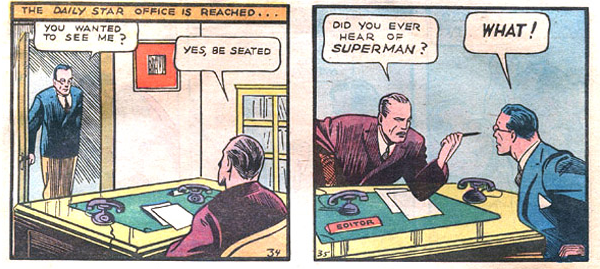
In virtually every version of Superman, Clark is an exercise in patient self-restraint, the ultimate man pretending day by day to be the ultimate common man. In his early days, this restraint was a superstrongman feat all its own, because Clark was extra pathetic—the better for Siegel, Shuster and the readers to identify with him.
I had crushes on several attractive girls who either didn’t know I existed or didn’t care I existed. So it occurred to me: What if I was really terrific? What if I had something special going for me, like jumping over buildings or throwing cars around or something like that?
Jerry Siegel [11]
Kent looked like Shuster, who later lifted weights for five years but never developed the bodybuilder’s confidence.[12] If Kent’s daily humiliations echoed Siegel’s past, they also predicted part of Shuster’s future.[13] When Shuster’s worsening eyesight drove him out of cartooning, he went back to deliveries, showing up at his former publisher carrying a package and wearing a ratty, worn-out suit.[14]
It’s not hard to imagine nerdy Shuster stammering “Sign here, please” in the same voice that Kent used to ask Lois, on their first date, if it wouldn’t be “reasonable” to let a bullying gangster have just one dance with her.[15]
Yet Shuster also drew Clark with a rock-hard physique that threatened to burst out of his jacket and pants at any moment. Every so often, after meekly tolerating an editor’s blustering or Lois’ icy contempt, “Clark” would crack a smile: if only they knew. For him, the angst Siegel and Shuster had felt in real life was just a pose, a suit he put on sometimes. And then he’d hear someone in trouble and strip off his shirt to reveal the S-shield underneath. The red trunks would soon follow. Underwear, for the underself.[16]
It was all just a game. Everything was going to be all right. Superman cheerfully presided over a world of bright rainbow colors where hurts and humiliations were temporary. Indeed, after a couple of years he developed a code against killing—a code most superheroes also followed.[17]
They also imitated the briefs, especially his most immediate peers—the original versions of Batman, Robin, Hawkman, Hourman, Starman, Dr. Fate, the Spectre, the Atom, and the Star-Spangled Kid all rocked the look as seen below. [18] And yes, more than half of those heroes also followed his “Somethingman” naming convention.
The 1960s and 1970s still saw plenty of new trunks-wearers among Avengers like Giant-Man and the Vision, mutants like Magneto, and gods like Orion. The Thing wore only trunks, and the Hulk torn purple pants. Other gods and mutants (Thor, Darkseid, the early X-Men) wore onesies broken up with a belt.[19] Strangely, two X-Men who each disdained the other’s sense of style—Cyclops and Wolverine—went full trunks-over-pants from the 1970s into the 1990s.[20]
This tendency to assign the look to gods and mutants, though, instead of more central figures like Captain America, Mister Fantastic, and Spider-Man, may have been an early sign that it was on its way out. These newer Marvel characters stood out from the first generation by being more fully realized people in their civilian identities, if not eliminating the dual identity altogether. Of the marquee Marvel heroes, only Thor, whose fashions and godly nature made him the exception that proved the rule, was introduced with a Clark Kentish self-denying secret identity.[21]
Superman’s influence continued to erode as the decades wore on. Newer heroes showed less interest in the code against killing or in names ending in “-man.”[22] And costume redesigns left the trunks behind. The X-Men got into black leather for a while, and their later, more colorful costumes still left the briefs out.[23]
Tim Burton’s 1989 Batman film “de-briefed” comics’ second most famous underwear wearer. Batman never went back to the briefs in any succeeding movies: they began to fade from the comics as well, as shown in this sample of Ben Moore’s larger survey of Bat-suits seen in various media, covering the period from 2005-2012.[24]
The look could still show up in the deliberately retro stylings of a film like The Incredibles; despite fashionista Edna Mode’s disdain for capes and insistence that “I never look back, darling, it distracts from the now,” her creations had an old-fashioned flair that matched the traditional values of their wearers, the kind of nuclear family that seemed to headline most sitcoms from the 1950s to the 1980s.[25]
Superman, for many years, seemed content to be a bit old-fashioned. His brand hadn’t been about “cool” for a long time: it was more about safety and stability. The comic-book Superman of 1962 or 1988 was more scientist than slugger, often approaching problems from a cool remove. His peers honored him as the one who came first, and therefore someone who didn’t need to follow the trends. He had, after all, defined them.[26]
Nevertheless, as superheroes and popular entertainment in general grew increasingly impatient with the “no kill rule,” the temptation to challenge Superman for wearing last year’s morals was overwhelming. The movies of the 1970s and 1980s danced around the issue by making Superman’s foes inanimate[27] or leaving their fates uncertain.[28] But many of his best-loved adventures, the ones that could claim to influence his canon, saw him sorely tempted to end a life—or even saw him succumb.
However, this was always an ending for the character as we knew him, as proved by what came next. In one such story, Superman instantly punished himself by giving up his super-powers and retiring.[29] In another, he died along with his foe.[30] In a third, he had a mental breakdown and went on a long journey of soul-searching before returning to duty with an even firmer vow, “Never again.”[31] In multiple stories of a world not our own, a world gone wrong, Superman deciding to kill is his first step toward villainy.[32] And at least once, he used magicians’ stage tricks to fool the world into thinking he’d broken his rule—just to show how terrible a Superman unchecked by restraint would be.[33]
The conservatism is unmistakable but charming. Nearly all fictional franchises create a moral universe that rewards readers for following them, and Superman is no exception. However much he struggled with it, refusing to kill would always be The Right Choice. Other heroes would always look to him for guidance, saluting his cape as if it were the flag. Underwear on the outside of your pants totally works.
The super-briefs stayed on for generations, in comics, movies, TV, Halloween costumes and branded, official kids’ underwear—an incentive to finish toilet training if ever there was one. [34]
And then everyone seemed to reject them at once. In 2011, Jim Lee redesigned all DC Comics’ top-selling characters, giving them the scratchy, slightly self-conscious “edginess” that had made Lee famous.[35] But the artist who had kept Cyclops and Wolverine in trunks now broke precedent. The red of Superman’s trunks shifted to his belt, and its buckle took a shape echoing the chest symbol. The trunks vanished.
I think you have to go for the core elements that are critical to the costume and freely change what looks dated… For me, the red trunks on Superman, you didn’t notice. It gets colored in blue anyhow.[36]
In the same year’s Action Comics, Grant Morrison and Rags Morales emphasized the populist strain in Siegel’s early, Depression-era stories. Theirs was a Superman for the 99 percent, and his costume was the believable result of a reporter’s salary: a screen-printed T-shirt, short cape, and jeans. [37] Morrison explained:
We felt it was time for the big adventures of a 21st-century Paul Bunyan who fights for the weak and downtrodden against bullies of all kinds, from robot invaders and crime lords to corrupt city officials. The new look reflects his status as a street-level defender of the ordinary man and woman.[38]
The filmmakers of 2013’s Man of Steel found the trunks clashed with their concept of the costume as alien armor. Even director Zack Snyder, whose adaptation of Watchmen had featured two trunks-over-pants designs to the comic books’ one,[39] now found himself breaking precedent.
The costume was a big deal for me, and we played around for a long time. I tried like crazy to keep the red briefs on him. Everyone else said, “You can’t have the briefs on him.” I looked at probably 1,500 versions of the costumes with the briefs on.[40]
Who stole Superman’s undies? Morrison takes responsibility for his part in it, Lee shrugs about careless colorists and readers, Snyder bows to the input of unnamed advisors. Their earlier output, though, suggests they had no dislike for the design, just a need to follow popular taste rather than acting as if Superman still shaped it. But fashion, as ever, sends a message about its wearer.
In Man of Steel, the blue is navy, the yellow rusty and gritty. Smallville’s Clark operates without a costume at all. Both versions of Superman are painfully unsure of themselves, closeted, desperate, and far less successful than earlier versions at preventing collateral damage.[41] Smallville averaged one death per episode in each season.[42] Superman’s first TV outing, The Adventures of Superman, averaged none—and lasted six seasons to Smallville’s ten.[43]
Analyst Charles Watson puts the Man of Steel death toll at 129,000, with the last of those deaths by Superman’s own hand.[44] Contrast this with Superman: the Movie, in which Superman saves everyone at risk from a devastating earthquake except Lois Lane, whom he then rescues via time travel. Man of Steel opened in eight times as many theaters as Superman: The Movie.[45] An influential new beginning, and by his old standards, an inauspicious one.
Man of Steel Superman may scream in anguish after killing General Zod, but unlike in the other stories where he crosses that line, he seems to get over it pretty fast. One scene later, he’s cheerfully knocking an Army drone out of the sky. He actually seems more relaxed and happy after the killing is done! No doubt Lois’ approval helps, but even so.
Man of Steel screenwriter David Goyer appears to be weaving some acknowledgments of that issue into its sequel.[46] He would like to assure you that the Superman you remember from your childhoods isn’t gone—he’s just not fully reborn yet.
Our movie was, in a way, Superman Begins; he’s not really Superman until the end of the film. We wanted him to have had that experience of having taken a life and carry that through onto the next films. Because he’s Superman and because people idolize him, he will have to hold himself to a higher standard.[47]
It’s true that Smallville and Man of Steel focus on a young Superman who hasn’t had a chance to become the graceful legend of earlier works. But these have been the portrayals to reach the widest audience in the last decade. [48] Even in current comics, though they have a lighter color scheme and mood, he’s an impulsive younger man with a quick temper.[49] The latest Superman project to be announced, TV’s Krypton, will take place thirty years before his birth.[50]
Put it all together and you’re left with the impression that Superman’s 21st-century caretakers would rather invoke the smiling, life-preserving, cool-headed circus superstrongman than actually show him. Will the next film change that? Will it give him the power and certitude to preserve all intelligent life in his path with a calm soul and a wink at the viewer? Or is that Superman no longer filmable, a relic to be tossed out like a pair of outgrown briefs?
Tights may tell.
[1] 1978’s Superman: The Movie earned nearly six times its budget and spearheaded the only superhero film franchise of the following decade.
[2] Some variation of Super Friends, always with Superman as the headliner, appeared on TV from 1973-1986.
[3] Eco and Natalie Chilton. “The Myth of Superman. The Amazing Adventures of Superman. Review.” Diacritics, 2(1), pp. 14-22. Spring 1972.
[4] Ellison, Foreword to Dennis Dooley and Gary Engle, Superman at 50: The Persistence of a Legend, 1987.
[5] Oxford English Dictionary entry, 2014. Found via Google search, November 22, 2014.
[6] Batman later used gadgets as sort of substitute super-powers, but other figures—the first Atom, Wildcat, and the Spirit, among others—used nothing but ordinary fists.
[7] Jerry Siegel (illustration by Joe Shuster), “The Reign of the Superman,” Science Fiction: The Advance Guard of Future Civilization #3, 1933.
[8] Les Daniels, Superman: The Complete History, 2004, p. 17.
[9] Jerry Siegel and Joe Shuster, Action Comics #1, 1938.
[10] Grant Morrison, Super Gods: What Masked Vigilantes, Miraculous Mutants and a Sun God from Smallville Can Teach Us About Being Human, 2012.
[11] Gerard Jones, Men of Tomorrow: Geeks, Gangsters and the Birth of the American Comic Book, 2005, p. 63.
[12] Tom Andrae with Geoffrey Blum and Gary Coddington, “The Birth of Superman,” Nemo #2, 1983.
[13] Craig Yoe, Secret Identity: The Fetish Art of Superman’s Co-creator Joe Shuster, 2009; Brad Ricca, Super Boys: The Amazing Adventures of Jerry Siegel and Joe Shuster—The Creators of Superman, 2013.
[14] Joe Simon, My Life in Comics, p. 188, 2011.
[15] Jerry Siegel and Joe Shuster, Action Comics #1, 1938.
[16] Alex Ross for Alex Ross and Paul Dini, Superman: Peace on Earth, p. 7, 1938.
[17] Editor Whitney Ellsworth was the driving force behind this rule, as early as 1940, years before the Comics Code Authority.
[18] Art by Jerry Ordway, Who’s Who in the DC Universe #12, 1986.
[19] Tim Leong, “A Venn Diagram of Superhero Tropes,” Super Graphic: A Visual Guide to the Comic Book Universe, 2013.
[20] Art by Jim Lee for X-Men #11, 1992.
[21] Dr. Donald Blake is more complicated than we can cover here,
[22] Wikipedia’s “List of notable superhero debuts” shows a tapering off of such names after the 1960s.
[23] Grant Morrison and Frank Quitely, New X-Men #114, 2001; Joss Whedon and John Cassaday, Astonishing X-Men #1, 2004.
[24] Selected from Ben Moore’s 2012 “Batman Infographic: Every Significant Bat-Suit Ever,” found at Screen Rant, http://screenrant.com/batman-infographic-every-batsuit-benm-144238/.
[25] Brad Bird, The Incredibles, 2004.
[26] Image by Jim Lee for DC Comics.
[27] In Superman: The Movie and Superman Returns, natural disasters are the chief problem; in Superman III and IV, the main villains are destroyed but arguably not truly alive.
[28] Superman II.
[29] Alan Moore, Curt Swan and Kurt Schaffenberger, Action Comics #583, 1986. Source of the image below and the last “Silver Age” Superman story.
[30] Dan Jurgens, Superman #75, 1992. The famous, notorious “Death of Superman.”
[31] John Byrne, Superman #22, 1988; Jerry Ordway, Adventures of Superman #450, 1989; Roger Stern and Kerry Gammill, Superman #28, 1989; George Perez, Action Comics #649, 1989. John Byrne’s last Superman story, and a heavy influence on Man of Steel in terms of who Superman kills and why.
[32] Central premise of the video game Injustice: Gods Among Us, released in 2013, ongoing storyline in the Justice League/Justice League Unlimited animated series (2001-2006) and invoked in the climax of 1996’s Kingdom Come by Mark Waid and Alex Ross.
[33] Joe Kelly and Doug Mahnke, Action Comics #775, 2001. Adapted into a 2012 direct-to-DVD animated film, Superman vs. The Elite.
[34] Photo from http://savinginsalinas.blogspot.com/2011/09/yard-sale-finds.html. Superman has had many adaptations but this was true of virtually all of them until 2011.
[35] Geoff Johns and Jim Lee, Justice League #1, 2011 (image source), and George Perez, Superman #1, 2011. Lee’s career goes back to 1987.
[36] WonderCon 2013 panel, “WC13: Jim Lee Talks DC, Answers Fan Questions and More!,” Comic Book Resources, March 30, 2013, http://www.comicbookresources.com/?page=article&id=44604.
[37] Grant Morrison and Rags Morales, Action Comics #2, 2011.
[38] Dareh Gregorian, “Bird? Plane? Superdude!,” The New York Post, July 18, 2011.
[39] Nite Owl wore them in both versions, but Ozymandias picked them up in the movie. Comics 1986-1987, film 2009.
[40] Reed Tucker, “‘Steel’ this movie,” The New York Post, November 25, 2012. Image from Man of Steel, 2013.
[41] In addition to the film itself, see Emma Dibdin, “‘Man of Steel’: Zack Snyder defends Superman’s ‘collateral damage,’” Digital Spy, August 30, 2013.
[42] According to smallville.wikia.com. In some seasons it was as high as three.
[43] 1952-1958; 2001-2011.
[44] Graphic by Chris Ritter, “The Insane Destruction That the Final ‘Man Of Steel’ Battle Would Do To NYC, By The Numbers,” Buzzfeed, http://www.buzzfeed.com/jordanzakarin/man-of-steel-destruction-death-analysis, June 17, 2013.
[45] Box Office Mojo. http://boxofficemojo.com.
[46] Devin Faraci. “Find Out Superman’s Situation In BATMAN V SUPERMAN,” Badass Digest, December 15, 2014.
[47] 2013 speech at the BAFTA and BFI Screenwriters’ Lecture series.
[48] 2006’s Superman Returns was far less profitable and problematic in a different way.
[49] Johns, Lee, and Morrison have confirmed this is deliberate.
[50] Lesley Golberg, “Syfy, David Goyer Developing Superman Origin Story ‘Krypton,’” The Hollywood Reporter, December 8, 2014.



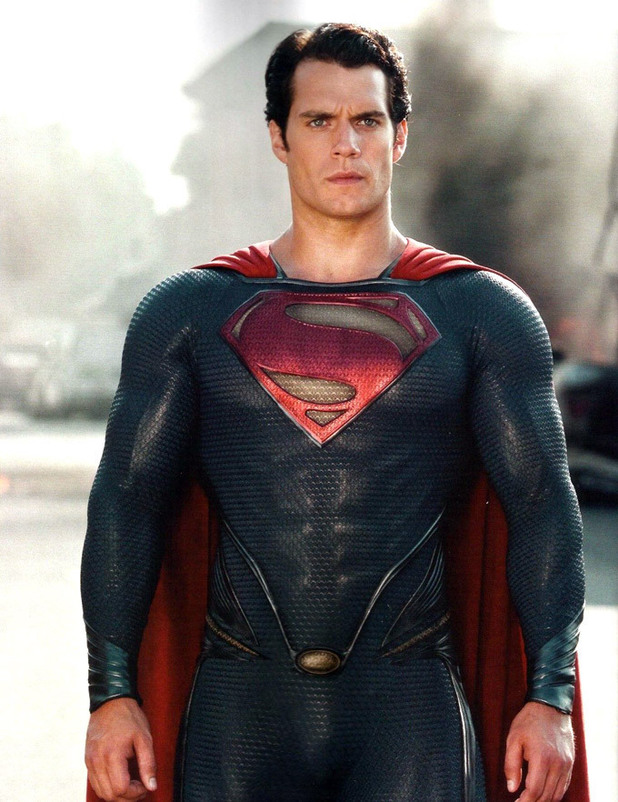

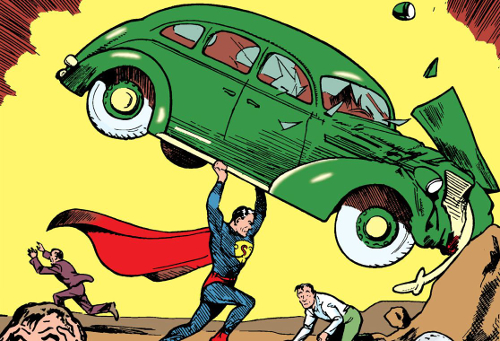





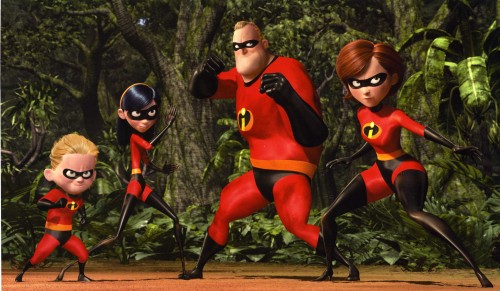






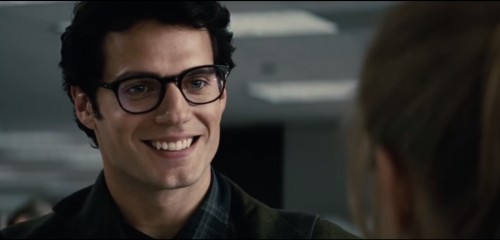
Hi name is Michael I have a website that is dedicated for collectibles and auctions I invite you to blog for free on my website as long as it has to do with collectibles and comic when you block on the site I will put your link to your website thank you.
Glad to see a Superman article even though it seems to still be stuck on digging into the man of steel movie yet again. It’s interesting to me that this commentary is picking on the red trunks issue again as well. I had thought it was a good move to update supermans costume personally. It’s interesting to me it wasn’t as big of a deal when Batman lost them. What’s also interesting to me that the article fails to mention that superman killed the 3 kryptonians in the dinner movie as well. And that superman in that movie was quite cheerful (and so was Lois) in doing so. At least in the man of steel he showe some regret. I have watched man of steel many times and I’m still somewhat confused as to how people are saying he caused the deaths when in fact it was zod throwing superman all over the place and using the terra former that was doing the damage. The avengers caused similar damage too. But nobody batted an eye. Captain America certainly did as well in the winter soldier, but every body’s fine with that too. As a superman fan, I can see people hold superman up to this odd standard that has to be perfect but at the same time hate him when he is depicted as such over the years. I personally thought the man I steel was a very well crafted superhero movie that rose above the usual superhero pop movies that Marvel has successfully produced. I am very eager to see the man of steel return to the theaters.
I think the reason Cap and Avenges did’t get the grief that MOS got is A) because you see the Avengers take concrete steps to contain the carnage (re – the perimeter that Tony kept around the alien attack and Cap’s directions to the police to aid in evacuating the civilians) and B) Cap often acts, esp in his first movie and Winter Soldier, as an agent of the government, and as a society, we’ve established that duly appointed government agents do have the ability to take a life under certain circumstances.
We miss Batman’s briefs less because they’ve always blended in more with the costume, and are not as ‘archetypical’ for the character. For Batman it’s the cowl with the ears, for Superman it’s the blue/red combination.
Take away the costume, and Superman ceases to be Superman. The other way around, if an actor can wear the costume (with pants) without looking silly, he’s fit to play Superman. Superman, blue suit, red cape, briefs and boots, is his own walking logo – changing that logo is also impacting what it stands for.
Maybe it’s me being an old coot, but there always was something comforting about Ma Kent having sown the costume, and giving her son a stack of spare capes on his birthday.
With taking away the briefs, DC has pretty much said: “We’re embarassed by the trunks over peejays look”, which is shame. It’d be as if Disney would give Donald pants because they’re embarassed about him walking around in his bare buns. That’s suspension of disbelief, people. If you can’t belief that a guy with multi-coloured spandex is a hero, you probably shouldn’t be bringing out superhero comics in the first place!
@Remco – agreed. Superman needing to wear scaly Kryptonian armor seems dumb. Much better to have it be something his mom made for him, reinforces the alien-raised-by-kindly-humans angle.
Superman did not kill the three Kryptonians in the “dinner” movie. It was a little ambiguous in the theater version of Superman II (which is really more of a Lester movie than a Donner one), but in the expanded TV version a couple of years later there was a deleted scene that clearly showed the police at the fortress arresting the three now-powerless villains.
S’right, Allen. Judging from the theatrical release seems like the fair thing to do, since probably more people have seen it, but even there, Zod and co. just kind of fall into a mysterious white mist. Hey, Superman could keep his suspended animation pit in there. It could happen! Some people certainly did look at that scene and go, “Oh, they’re totally dead,” but there’s considerably more room for interpretation that what happens to Zod in Man of Steel. I tried to sum up all that with the word “ambiguous.”
(And I’d add that I’m pretty sure the ambiguity was purposeful. This was still considered a “family movie” and the ideas about what kids could handle were considerably different in 1980, too.)
For me, Man Of Steel wanted to provide a fresh new take on Superman and not re-tread what everybody already knows. It went big, and it went epic like a Superman movie should. And the Zod death was actually something I had read before in the comics as well, and something people in the mainstream weren’t expecting.
I believe Warner Brothers tried to make a Superman that was in-line with the Donner films as best they could with Superman Returns by Brian Singer. And even though I liked that as well, I thought it was just impeded too much by the past and just seemed dated at this point. Updating Superman to be flawed for MOS, I thought was a good idea. There’s definitely an odd bias I see against Superman as opposed to Batman. Batman has been re-defined multiple times and has gone from campy to serious through the ages, but for some reason people don’t think the same should be done with Superman even when it’s done well. And like I said, the flip side when Superman is done in his classic style? Nobody cares.
@Remco To me, Superman’s costume is as iconic as Batman’s and as it was okay to lose Batman’s briefs it’s also okay to lose Superman’s. Superman’s iconic look is still iconic even without the briefs. Morrison’s Jeans and T-shirt look was pretty cool to me, and the Kryptonian battle armor has actually grown alot on me and I like it. Batman has gotten very tech’d out and everybody seems to be okay with that. I personally think he still shouldn’t have body armor like he does nowadays, but I’m okay with it. But Superman? He just can’t catch a break. I feel that the general consensus is that he should stay in the past and not get updated. And as a fan? That scares me a little bit.
As for Captain America being a government agent and that makes it okay to take lives, I can see that and understand the logic. It’s certainly not the Captain America I know, but again it’s a sign to me that Captain America has been allowed to evolve, but Superman has not.
BTW if I’m coming across as being overly agressive and offensive, to the writer of the article as well, I apologize in advance. I’m a giant nerd when it comes to Superman, and I’ve re-watched Man of Steel so many times because I really did enjoy the movie and am trying to wrap my head around why there’s a lot of hate (and I do mean Hate with a capital H) for it. I sincerely do believe it’s one of the better Superhero movies out there. So sorry if I’m a long-winded jerk.
Apropos of nothing really, I watched about a third of the first Superman tonight and…wow, that movie never stops being perfect.
“Apropos of nothing really, I watched about a third of the first Superman tonight and…wow, that movie never stops being perfect.”
As I’ve often told friends, the first half of Superman: The Movie is as close to a David Lean film as superhero movies get, with its character-driven storytelling and sweeping camera shots of middle America. And the crane shot over the wheat fields after Clark tells Ma he has to leave…it’s magical, when paired with John Williams’s score.
But when we get to Otis and “Mistah Luu-torrr” and “MISS. TESS-MAAA-KERRR!” it all sort of devolves into a big-budget, Lorenzo Semple-scripted Batman episode. Although it could have been worse, according to the (apocryphal?) tale that Mario Puzo wanted Luthor chewing Kleenex to show how crazy he was.
Also: Glenn Ford is the best Pa Kent ever: strong, compassionate, supportive. When he dies, it’s a heartbreaking scene. I was so disappointed with Man of Steel’s paranoid, let-the-bus-full-of-kids-drown version. When I heard that Kevin Costner had been cast, I thought, “Of course! Superman’s dad is Ray Kinsella from Field of Dreams–that’s perfect.” And then Snyder and Goyer’s take on the character turned out to be so, so wrong. When he dies, it’s, “Well…that was just stupid.”
Had Donner and the Salkinds combined the 1st and 2nd halves of, respectively, the 1st and 2nd Superman flms, we may well have ended up with the perfect movie.